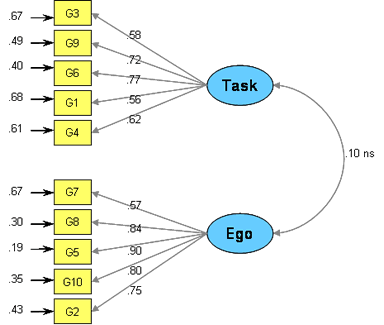The Goal Orientations in Exercise Scale (GOEM)
 According
to the achievement goal theory approach to understanding achievement motivation
in educational settings, goal orientations represent individual differences
in the ways that people construe success. Two major goal perspectives
are proposed: task-oriented goals and ego-oriented goals (also known as
learning and performance goals respectively). When task-oriented, individuals'
conceptions of ability are self-referenced and dependent upon personal
improvement and task-mastery. When ego-oriented, conceptions of ability
are normatively-referenced and based upon comparisons with the performance
of others.
According
to the achievement goal theory approach to understanding achievement motivation
in educational settings, goal orientations represent individual differences
in the ways that people construe success. Two major goal perspectives
are proposed: task-oriented goals and ego-oriented goals (also known as
learning and performance goals respectively). When task-oriented, individuals'
conceptions of ability are self-referenced and dependent upon personal
improvement and task-mastery. When ego-oriented, conceptions of ability
are normatively-referenced and based upon comparisons with the performance
of others.
A considerable body of research attests to the applicability of this approach to understanding motivation in sport and physical education settings. However, some researchers have questioned whether the approach is applicable to motivation for recreational and health-related exercise because they do not view the exercise context as an achievement domain. It has been argued that task- and ego-orientations may not be relevant to physical activity that is not expressed directly toward competition and the demonstration of physical skills. Clearly, however, exercise contexts do offer opportunities for both personal improvement and social comparison and research has shown the importance of individual differences in the types of exercise goals or motives that individuals adopt and subsequent variations in exercise investment. Kilpatrick, Bartholomew and Riemer (2003) addressed the applicability of the goal orientations approach to exercise domains by developing the Goal Orientation in Exercise Scale (GOES). However, this measure was derived directly from the Task and Ego Orientation in Sport Questionnaire (Duda, 1989), which has been criticized on the grounds that the task scale confounds processes (e.g. effort) with the products of achievement. Consequently we (Petherick & Markland, 2009) have designed a new measure of goal-orientations for exercise contexts, the Goal Orientations in Exercise Measure (GEOM).
GOEM Development and Psychometric Properties
372 participants recruited from physical activity clubs responded to an initial item pool derived from existing instruments and current theorising on the structure of goal-orientations, and approved by an expert panel (248 females [mean age = 42.1, sd = 13.1], 124 males [mean age = 41.1, sd = 11.1). The original intention was to incorporate a four-dimensional conceptualisation of goal-orientations adapted from Harwood, Wilson and Hardy (2002). This model distinguishes between four dimensions of goal-orientations: social-approval task, social-approval ego, self-directed task, and self-directed ego. However, initial analyses showed that there was considerable overlap between these factors but a clear distinction between task- and ego-goals, and so the model was collapsed into the traditional two-dimensional framework of task- and ego-orientations. The final two dimensional model, with five task and five ego items, had an excellent fit to the data (Satorra-Bentler chi sq = 45.45, df = 34, p > .05; rmsea = .03, 90% CI = .00:.05; CFI = .99; srmr = .04). The task and ego factors were orthogonal (r = .10 ns). Cronbach's alphas for the scales were .78 (task) and .88 (ego). Multisample model testing showed that the model was invariant across gender. The figure below shows the parameter estimates.

Construct Validity
In the development study, we administered the GOEM along with the Social
Physique Anxiety Scale (Hart, Leary, & Rejeski, 1989), the Behavioural
Regulation in Exercise Questionnaire (BREQ-2: Markland & Tobin, 2004),
a measure of perceived ability (Hall, Kerr & Matthews, 1998), and
a measure of perceived threat (Endler, Edwards, & Vitelli, 1991).
Task orientation was significantly positively related to intrinsic, identified,
and introjected regulation from the BREQ-2, and perceived ability, whilst
being significantly negatively related to external regulation and amotivation
from the BREQ-2, and social physique anxiety. Ego-orientation was significantly
and positively related to introjected and external regulation, perceived
ability and perceived threat.
GOEM Scoring
The GOEM is scored by calculating the means for the five items of each subscale. The scoring key is:
|
Task
|
Ego
|
||
| Item 1 | Item 2 | ||
| Item 3 | Item 5 | ||
| Item 4 | Item 7 | ||
| Item 6 | Item 8 | ||
| Item 9 | Item 10 |
References
Duda, J.L. (1989). The relationship between task and ego orientation and the perceived purpose of sport among male and female high school athletes. Journal of Sport & Exercise Psychology, 11, 148-165.
Elliot, A.J. & Church, M.A. (1997). A hierarchical model of approach and avoidance achievement motivation. Journal of Personality and Social Psychology, 72, 218-232.
Hart, E. A. Leary, M. R. & Rejeski, W. J. (1989). The measurement of social physique anxiety. Journal of Sport & Exercise Psychology, 11, 94-104.
Harwood, C., Wilson, K., & Hardy, L. (2002). Achievement goals in sport: Working towards an alternative model. Journal of Sports Sciences, 21, 349-350.abstract
Kilpatrick, M., Bartholomew, J. & Riemer, H. (2003). The measurement of goal orientations in exercise. Journal of Sport Behavior, 26, 121-136.
Markland, D. & Tobin, V. (2004). A modification to the Behavioural Regulation in Exercise Questionnaire to include an assessment of amotivation. Journal of Sport and Exercise Psychology, 26, 191-196. abstract
Petherick, C. & Markland. D. (2008). The Development of a Goal Orientation in Exercise Measure (GOEM). Measurement in Physical Education and Exercise Science, 12, 55-71.
